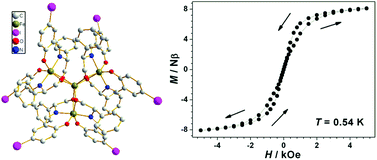A family of enantiopure FeIII4 single molecule magnets: fine tuning of energy barrier by remote substituent†
Abstract
A new family of enantiopure star-shaped FeIII4 single-molecule magnets (SMMs) with the general formula [Fe4(LK)6] (H2L = (R or S)-2-((2-hydroxy-1-phenylethylimino methyl)phenol); K = H (1), Cl (2), Br (3), I (4), and t-Bu (5)), were structurally and magnetically characterized. Complex 1 was reported in our previous paper (Chem. Commun., 2011, 47, 8049–8051). Detailed magnetic measurements and a systematic magneto-structural correlation study revealed that the SMM properties of this series of compounds can be finely tuned by the remote substituent of the ligands. Although the change in the coordination environment of the central Fe3+ ions is very small, the properties of SMM behavior are changed considerably. All five complexes display frequency dependence of the ac susceptibility. However, the χ′′ac peaks of complexes 2 and 5 cannot be observed down to 0.5 K. The fitted anisotropy energy barriers (Ueff) of complexes 1, 3, and 4 were 5.9, 7.1, and 11.0 K, respectively. Moreover, the hysteresis loops of these three complexes can be also observed around 0.5 K. Magneto-structural correlation analyses revealed that the coordination symmetry of the central Fe3+ ion and the intermolecular interaction are two key factors affecting the SMM properties. Deviation to a trigonal prism coordination environment and the existence of intermolecular interactions between neighboring clusters may both reduce the anisotropy energy barriers.


 Please wait while we load your content...
Please wait while we load your content...